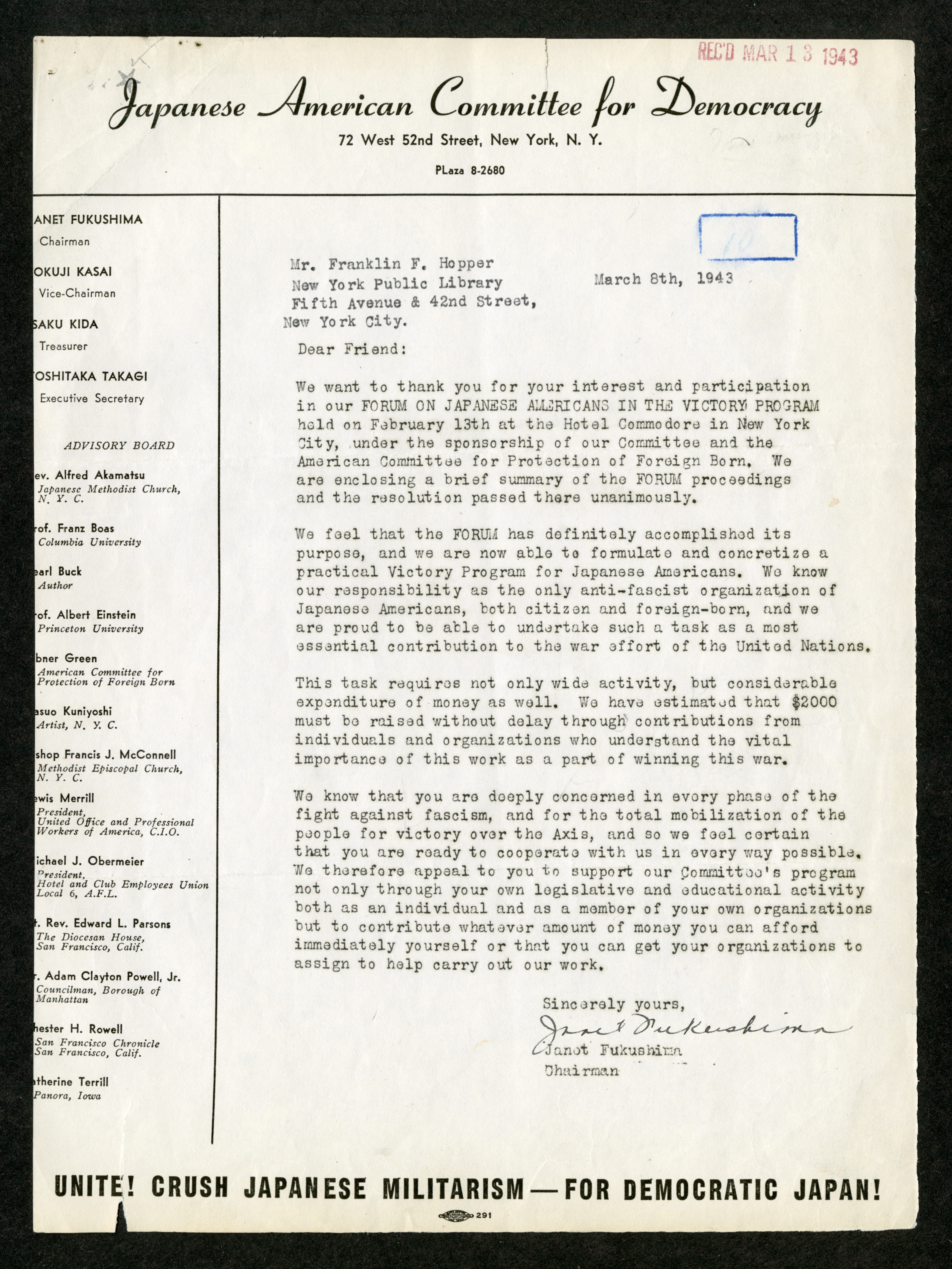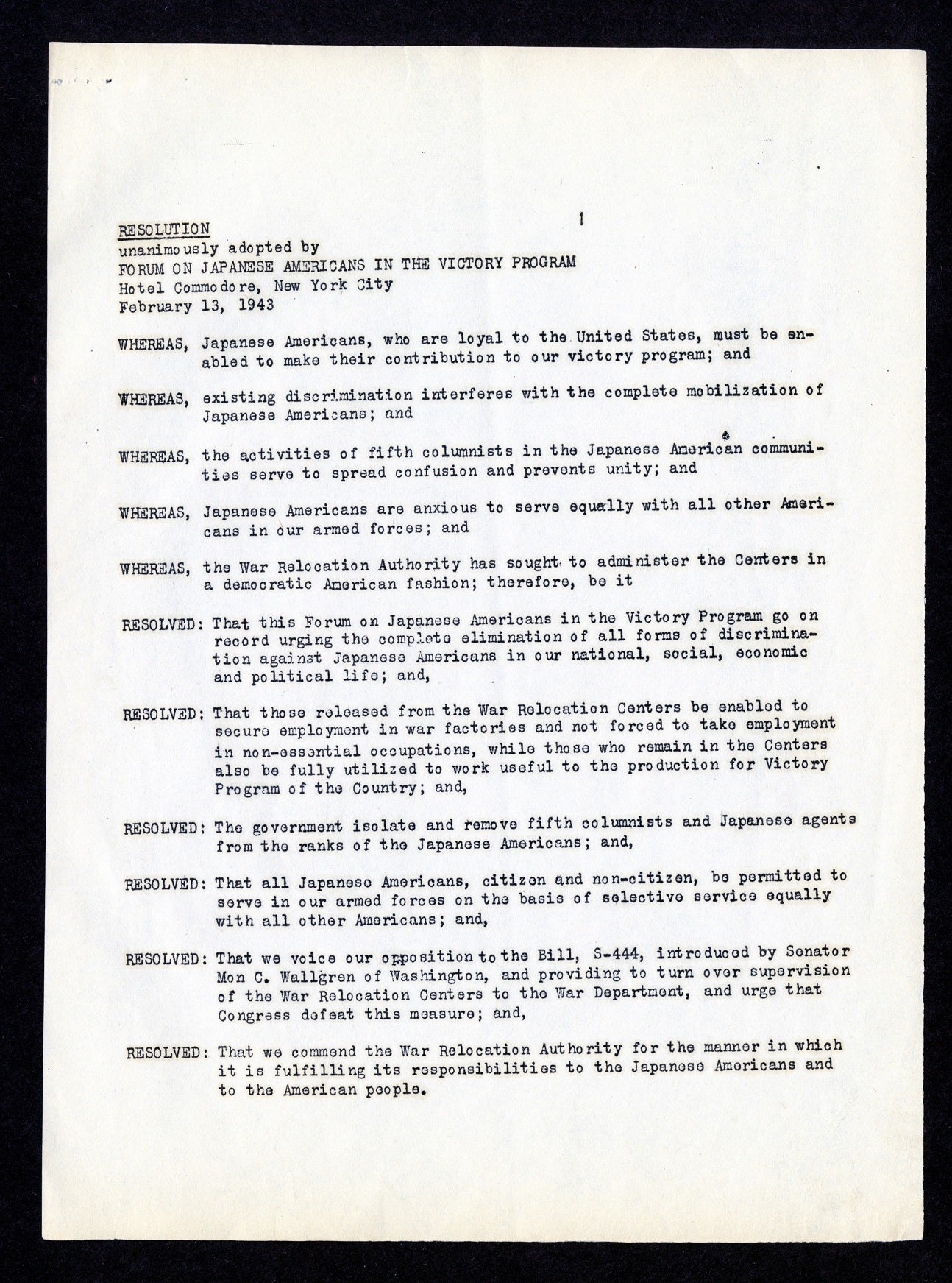Asian Pacific American Heritage Month: Japanese American Committee for Democracy
Posted by Gilder Lehrman Staff on Friday, 05/03/2019
May is Asian Pacific American Heritage Month, recognizing the achievements and contributions of Asians and Pacific Islanders to the history and culture of the United States. Senators Daniel K. Inouye and Spark Matsunaga of Hawaii, along with Representatives Frank Horton of New York and Norman Y. Mineta of California, introduced similar bills in 1977 to declare the first ten days of May Asian-Pacific Heritage week. They chose the month of May to commemorate two important dates in American history: Japanese immigration to the United States began on May 7, 1943, and the first transcontinental railroad was officially completed on May 10, 1869, thanks to the work of thousands of Chinese immigrants. President Jimmy Carter signed the joint resolution designating the celebration in 1978. In 1990, President George H. W. Bush signed a bill establishing the entire month of May as Asian-Pacific American Heritage Month
 We highlight today the efforts of the Japanese American Committee for Democracy, represented in the Gilder Lehrman Collection with a 1943 call for organizations (in this case, the New York Public Library) to rally to the cause of ending discrimination against Japanese Americans and to help patriotic Japanese Americans participate in the war effort.
We highlight today the efforts of the Japanese American Committee for Democracy, represented in the Gilder Lehrman Collection with a 1943 call for organizations (in this case, the New York Public Library) to rally to the cause of ending discrimination against Japanese Americans and to help patriotic Japanese Americans participate in the war effort.
In February 1942, President Franklin Roosevelt signed order 9066, authorizing the relocation of any people from designated military zones for national security. On May 3, 1942, the army issued the order for forced relocation and confinement of more than 110,000 Japanese nationals and Japanese Americans living in the West. While the rationale was war-related, the action stemmed from a century of discrimination against Asians and Asian Americans. More than 135,000 Japanese immigrants had entered the country between 1900 and 1908, with most making their homes on the West Coast. Labor unions, newspapers, and politicians urged the United States and Japan to enter into a “Gentleman’s Agreement” in 1908 to reduce Japanese immigration. In 1924, the United States prohibited Japanese immigration entirely. Japanese immigrants already in the US were barred from citizenship, but their children born in the United States were automatically citizens. Despite the discriminatory practices, many Japanese people held good jobs, started businesses, and owned their own homes.
Pressure mounted in 1942 to enact the Civilian Exclusion Orders in West Coast cities, which forced the majority of West Coast Japanese Americans into internment camps for the entirety of World War II.
 Meanwhile, in New York, a coalition of Japanese Americans who had not been interned formed the Japanese American Committee for Democracy (JACD). This group was a reconstitution of an earlier group, the Committee for Democratic Treatment for Japanese Residents in Eastern States, founded in 1940. On February 13, 1943, the JACD conducted a Forum on Japanese Americans in the Victory Program. The main resolution coming out of the forum advocated recognizing that patriotic Japanese Americans should not be discriminated against and should be allowed to actively participate in military duty. Following the forum, JACD Chairman Janet Fukushima sent out summary reports and suggested steps organizations might take to aid loyal Japanese Americans. In part, the letter operated as a fundraising effort for JACD.
Meanwhile, in New York, a coalition of Japanese Americans who had not been interned formed the Japanese American Committee for Democracy (JACD). This group was a reconstitution of an earlier group, the Committee for Democratic Treatment for Japanese Residents in Eastern States, founded in 1940. On February 13, 1943, the JACD conducted a Forum on Japanese Americans in the Victory Program. The main resolution coming out of the forum advocated recognizing that patriotic Japanese Americans should not be discriminated against and should be allowed to actively participate in military duty. Following the forum, JACD Chairman Janet Fukushima sent out summary reports and suggested steps organizations might take to aid loyal Japanese Americans. In part, the letter operated as a fundraising effort for JACD.
The JACD went on to join forces with the Chinese Laundrymen’s Alliance to rally for the repeal of the Chinese Exclusion Act and campaign for a bill to legalize naturalization for all Asian immigrants. The JACD also partnered with the National Negro Congress in 1944 to support the re-election of President Franklin D. Roosevelt.
After the war, JACD activity tapered off, though it existed long enough to send a contingent to the 1947 May Day Parade. Relocations camps notwithstanding, approximately 33,000 Japanese Americans served in the military during or shortly after World War II; an estimated 800 of them were killed in action.
In December 1944, the Supreme Court ruled in Ex parte Endo, a lawsuit brought by Mitsuye Endo, one of the detainees, that relocation camps were unconstitutional and that the War Relocation Authority had “no authority to subject citizens who are concededly loyal to its leave procedure.” The day before the Court released its decision, the War Department announced the lifting of the West Coast exclusion orders and the impending closure of the relocation centers. The last Japanese internment camp, the high-security center at Tule Lake, California, was closed in March 1946.